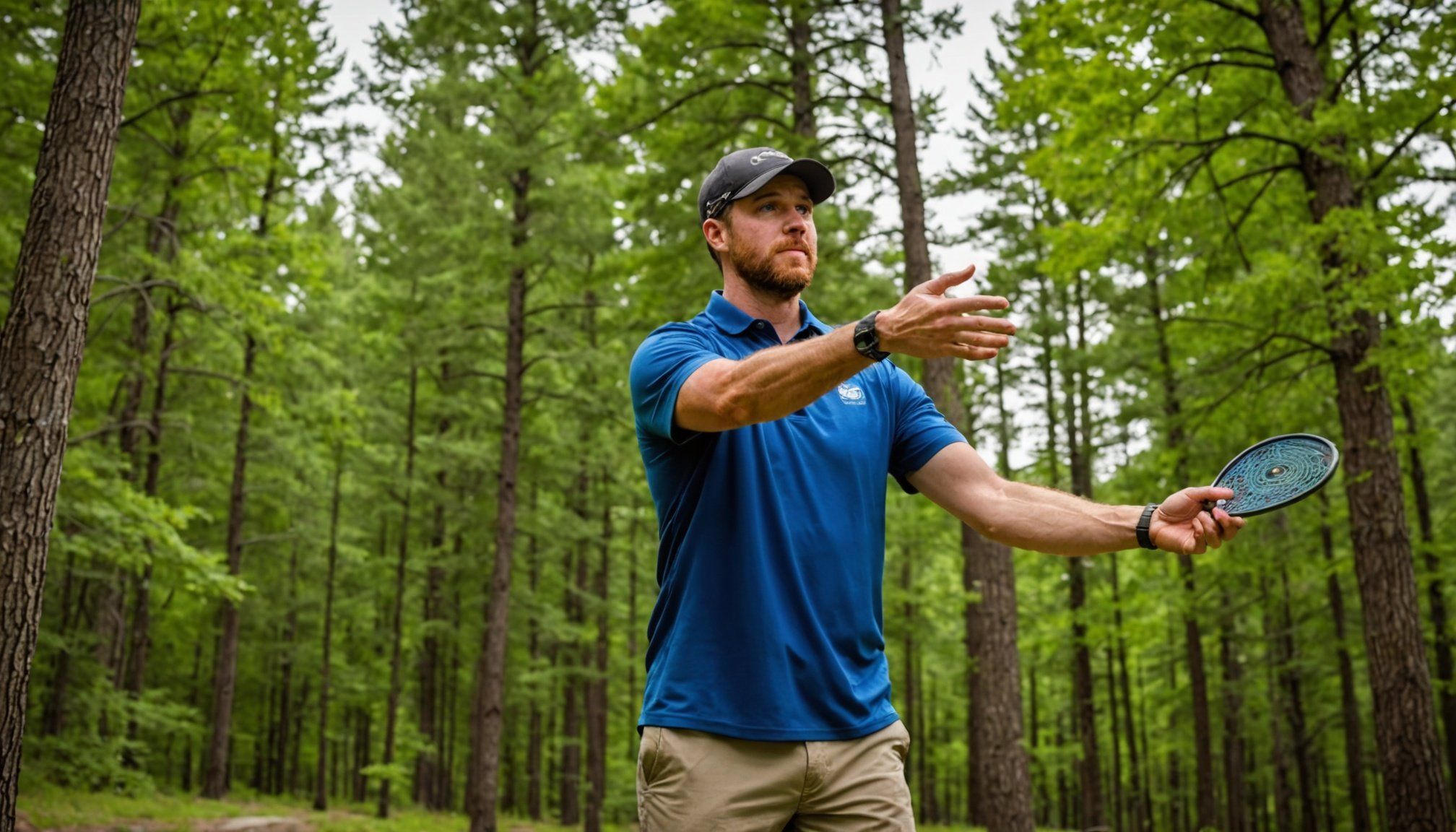Importance of Grip in Disc Golf
Understanding the importance of grip in disc golf is crucial for improving throw precision. The grip directly affects the way a disc flies, influencing both accuracy and distance. Grip techniques play a significant role in steady and controlled throws. A poor grip can lead to inconsistent releases, often causing the disc to veer off the intended path.
Common mistakes include holding the disc too loosely or tightly, which can both detract from disc golf accuracy. It’s essential to find the right balance, allowing for a firm hold that doesn’t compromise flexibility or control. Addressing these issues can significantly reduce performance errors.
Additional reading : Revolutionizing Football Injury Rehab: How Interdisciplinary Teams Boost Athlete Recovery
Moreover, developing a consistent grip is key to a player’s success. As each throw relies on a dependable foundation, grip techniques help build a robust, repeatable throw. Practising these techniques fosters consistency, leading to improved accuracy over time. Engaging in consistent practice allows players to adapt and refine their grip for different shots, enhancing overall performance.
In essence, refining grip techniques is indispensable for disc golf precision, providing players with the confidence to tackle varying in-game scenarios efficiently.
Also to discover : Key Techniques for Effective Psychological Debriefing After Intense Equestrian Competitions
Overview of Grip Styles
Grasping the types of grip in disc golf can dramatically influence your game, as each grip style offers unique advantages. Selecting the appropriate disc golf grips can impact both the flight and distance of your throws.
Power Grip
The Power Grip is known for maximizing distance. By placing all four fingers firmly beneath the disc’s rim and pressing the thumb on top, this grip creates intense propulsion power. It is popular among professional players for long-distance drives but may sacrifice some precision.
Pinch Grip
In contrast, the Pinch Grip enhances control, making it ideal for mid-range shots. This technique involves pinching the disc between the thumb and index finger while the other fingers support the underside. Utilized by many experienced players, it balances precision and stability, though it may reduce throwing distance.
Modified Grip
Finally, the Modified Grip combines elements of both previous styles. This versatile grip allows players to adjust their hold depending on the in-game scenario. It is particularly useful when adapting to varying wind conditions or unique course challenges, offering a balanced blend of control and power for a wider array of shots.
Techniques for Improving Grip
Enhancing grip techniques is essential for improving disc handling and overall performance. These methods provide step-by-step instructions to establish a solid grip, necessary for executing consistent and controlled throws. Begin by aligning your fingers evenly along the disc’s rim. Maintain a firm yet flexible hold, allowing adequate freedom of movement without over-tightening. A balanced approach helps in managing varying shots effectively.
Regular practice is crucial. Incorporate drills specifically focused on enhancing grip. Simple activities, like squeezing a stress ball or using resistance bands, can significantly boost finger strength and control. Engaging in these exercises consistently reinforces your muscle memory, resulting in a more reliable grip during play.
Moreover, implement mental strategies to maintain a consistent grip under pressure. Visualize each throw, preparing mentally before executing the shot. This technique aids in calming nerves and maintaining focus, ensuring your grip remains stable when it matters most.
Remember, practicing these throwing techniques diligently enhances your ability to handle the disc under diverse conditions, ultimately contributing to better overall disc golf accuracy and refinement of your personal style.
Exercises to Strengthen Grip
Building strong grip muscles is essential for enhancing both disc golf fitness and overall performance. Grip strength exercises target the hands, forearms, and fingers, crucial areas for achieving powerful throws.
Hand Strength Exercises
To boost hand strength, incorporate activities like squeezing a stress ball or using a grip trainer. These exercises help in developing the endurance needed for repetitive throwing without fatigue. Regular practice increases muscle stamina, pivotal for sustaining control during extended gameplay.
Forearm Conditioning
For forearm conditioning, wrist curls and reverse curls with light dumbbells are effective. These workouts enhance the muscles’ capacity to exert force, which is beneficial for adding power to your throw. Including these exercises in your training regimen can significantly impact your throw distance and speed.
Finger Dexterity Drills
Enhance finger dexterity by engaging in exercises like finger-tapping on tabletops or using rubber bands to create resistance. Developing finger strength ensures precise control over the disc, improving accuracy and the quality of release. Adding such drills to your routine fosters better handling and flexibility, pivotal for maneuvering different disc grips effectively.
Tips from Professional Players
Gaining insights from top disc golf professionals can dramatically enhance your game. Their firsthand experiences provide invaluable guidance for mastering grip techniques. Nicholas Herm, a leading player, emphasizes the importance of a consistent grip for achieving dependable throw precision. He suggests focusing on grip relaxation to prevent tension, which can lead to erratic flights.
Professional advice serves as a beacon for improving disc golf accuracy. Paige Pierce, a five-time women’s disc golf champion, advises players to adapt their grip styles based on environmental conditions. She explains how altering your hold can effectively counteract wind resistance, thereby increasing control.
Moreover, examining case studies of successful players can shed light on grip techniques that impact performance. Ken Climo, known for his numerous championship titles, attributes his success to balancing grip firmness with flexibility. He highlights the role of refining grip styles in developing consistent, powerful throws.
By embracing these expert tips and adapting them to your play style, you unlock the potential for remarkable improvement—guiding you towards precision, control, and confidence in your game.
Comparing Grip Techniques
Exploring and comparing grip techniques is essential for identifying the most effective methods for various throwing scenarios in disc golf. Each grip type, whether it’s the Power, Pinch, or Modified Grip, offers distinct advantages and limitations depending on the context of the game.
Performance Analysis
When evaluating grip effectiveness, it’s important to analyse performance under different conditions. The Power Grip is often favoured for maximizing distance on open courses, while the Pinch Grip enhances control, making it suitable for tight, technical shots. The Modified Grip offers versatility, allowing players to adapt to changing conditions effortlessly.
Grip and Throw Types
Understanding the relationship between grip and throw types can optimize disc golf accuracy. For long-distance throws, a tighter grip may generate more power, whereas a looser grip can help with more controlled, shorter shots. Experimenting with variations can reveal which combination yields the best results for your play style.
Pros and Cons of Each Grip
Consider the pros and cons when selecting the right grip technique. While the Power Grip provides power, it may reduce precision. Conversely, the Pinch Grip offers control but might limit distance. Balancing these factors is key to perfecting your throw for each specific situation.
Conclusion and Next Steps
Achieving disc golf improvement requires thoughtful integration of learned grip techniques into daily practice routines. To enhance your game, focus on gradually incorporating advanced grip methods, meticulously observing changes in performance. Pay attention to how different grip styles affect your throw and adjust accordingly. This exploration fosters personal growth and develops a unique playing style.
Suggested resources for further study include video tutorials from top players, workshops held by disc golf clubs, and books focused on mastering grip techniques. Diving into these materials expands your understanding and offers new insights into effective practices and strategies. Seek feedback from experienced players or coaches to refine your approach further.
Finally, embrace an encouraging mindset as you experiment with different grip techniques. This explorative process is vital for uncovering the grip styles best suited to your individual needs. Be patient with yourself as you refine your throws, remembering that every player progresses at their own pace. By continuously exploring grips and adapting to various game conditions, you set yourself up for substantial performance enhancement and enjoyment in disc golf.










